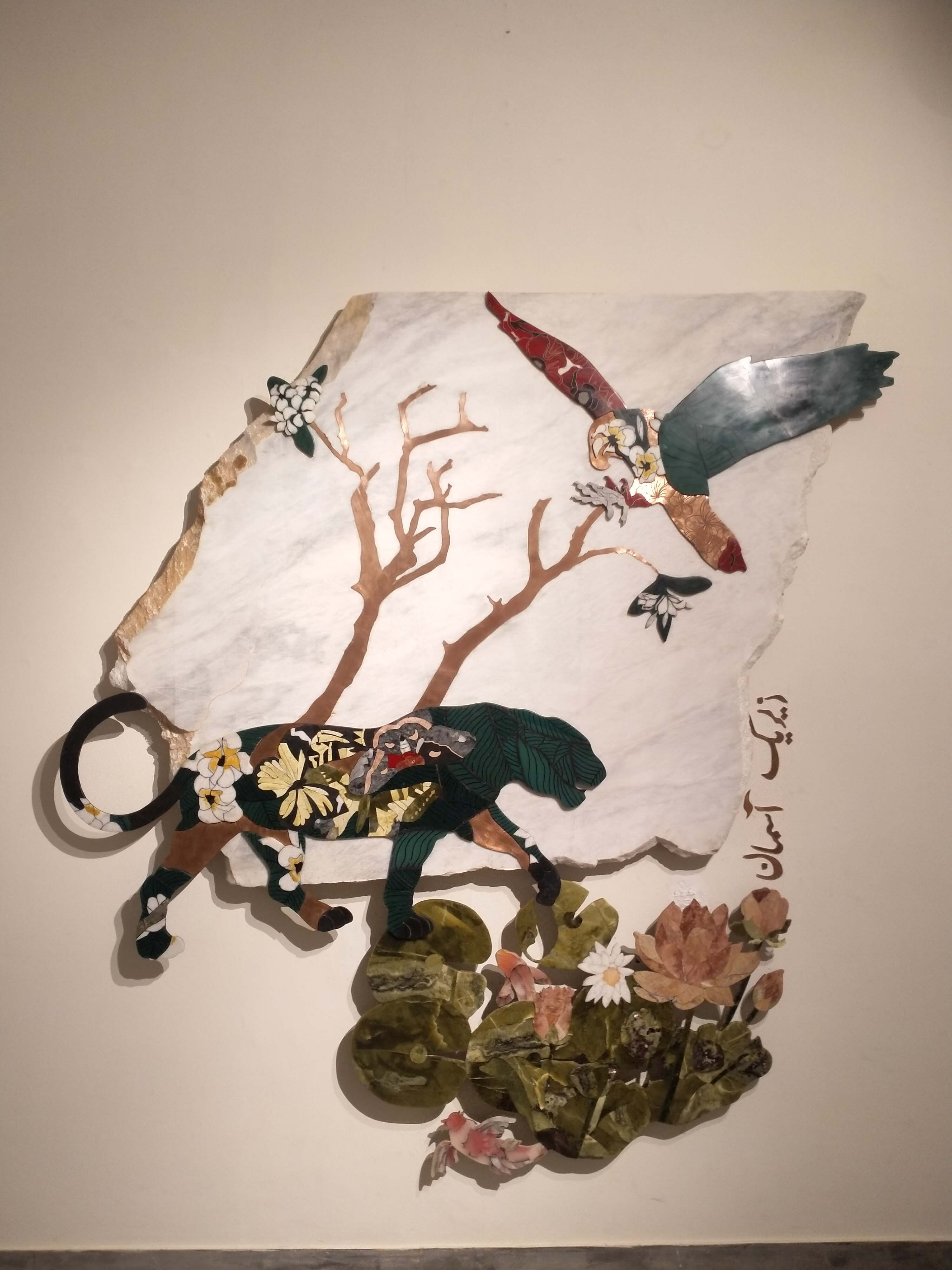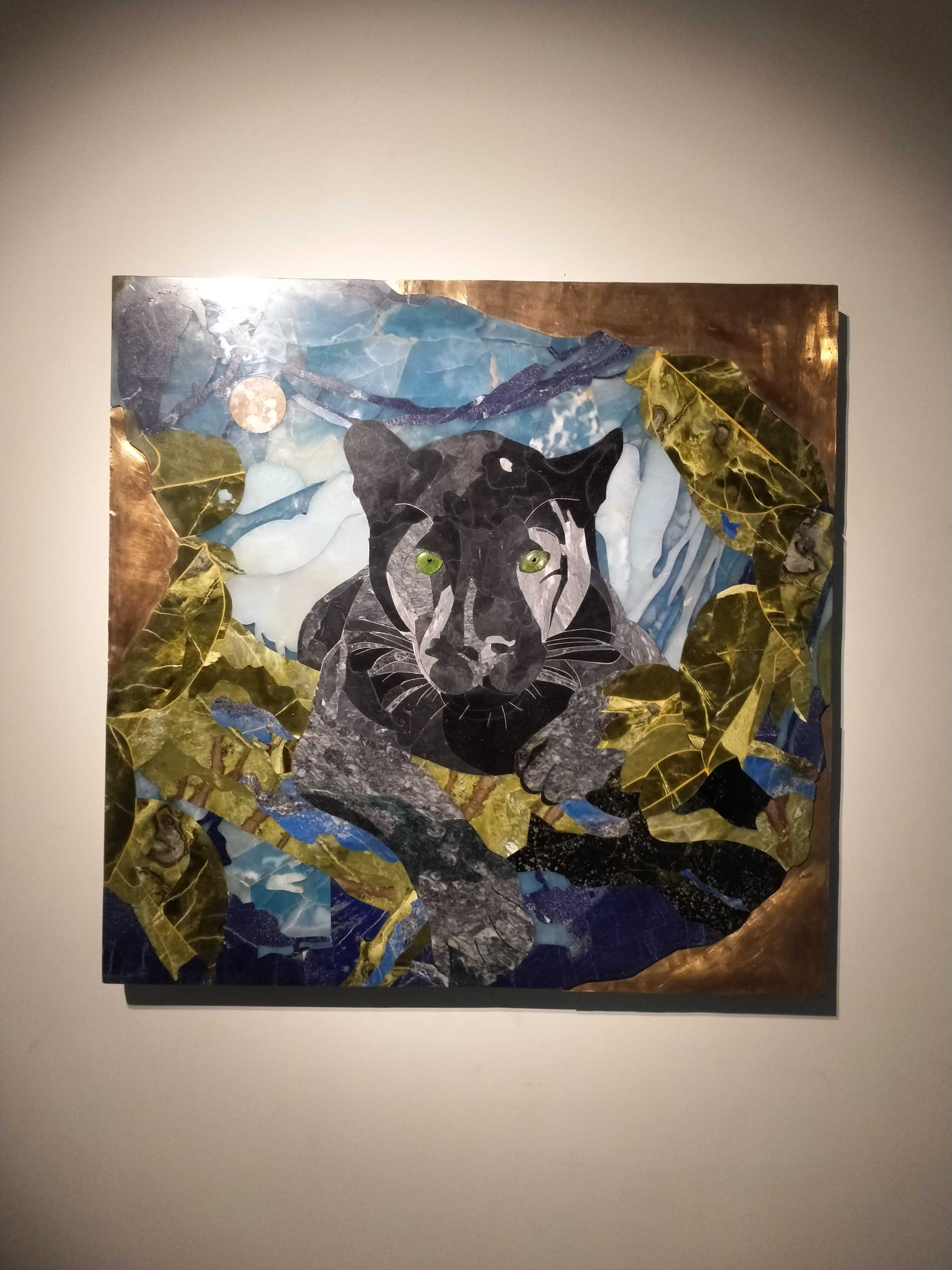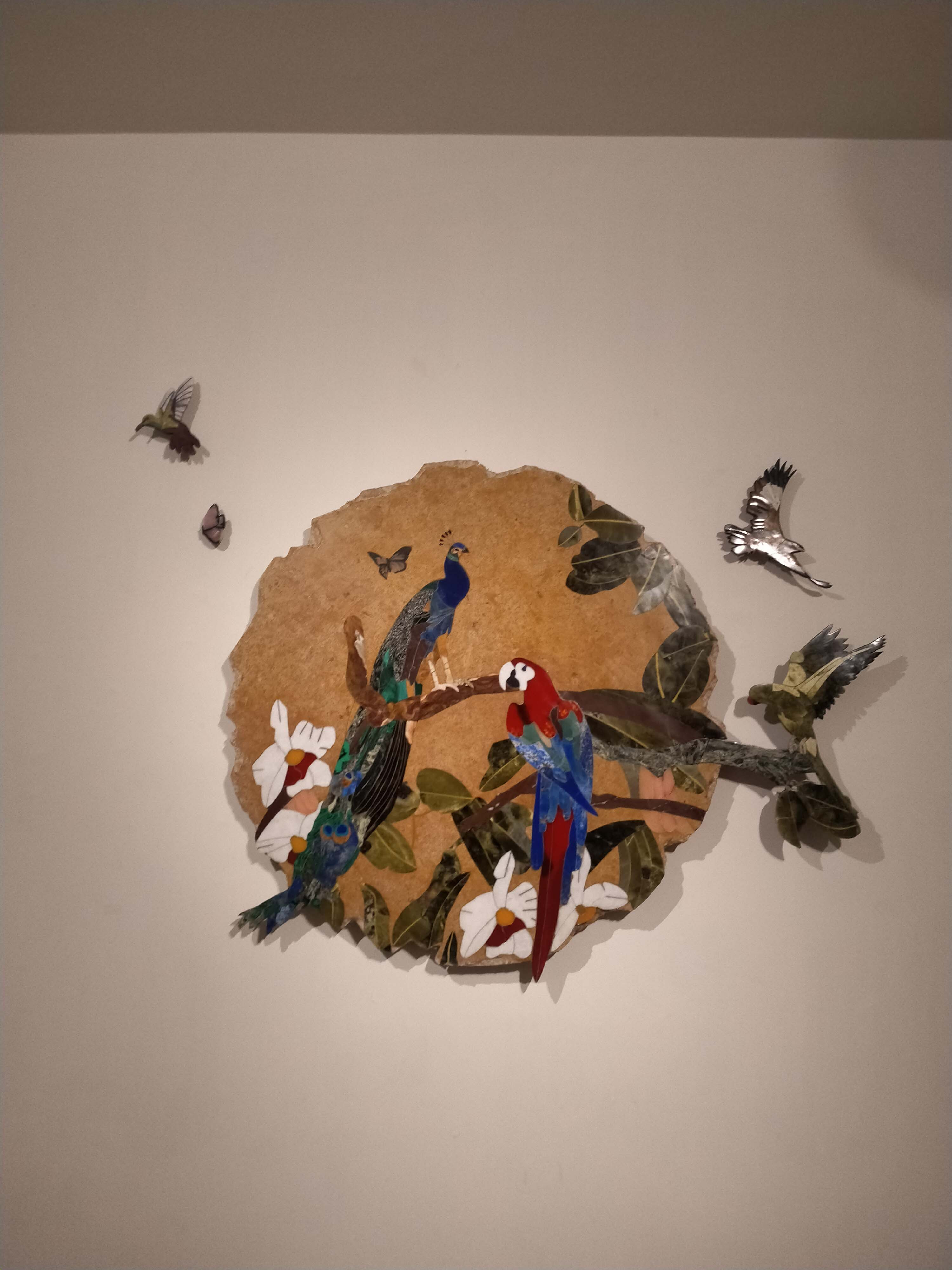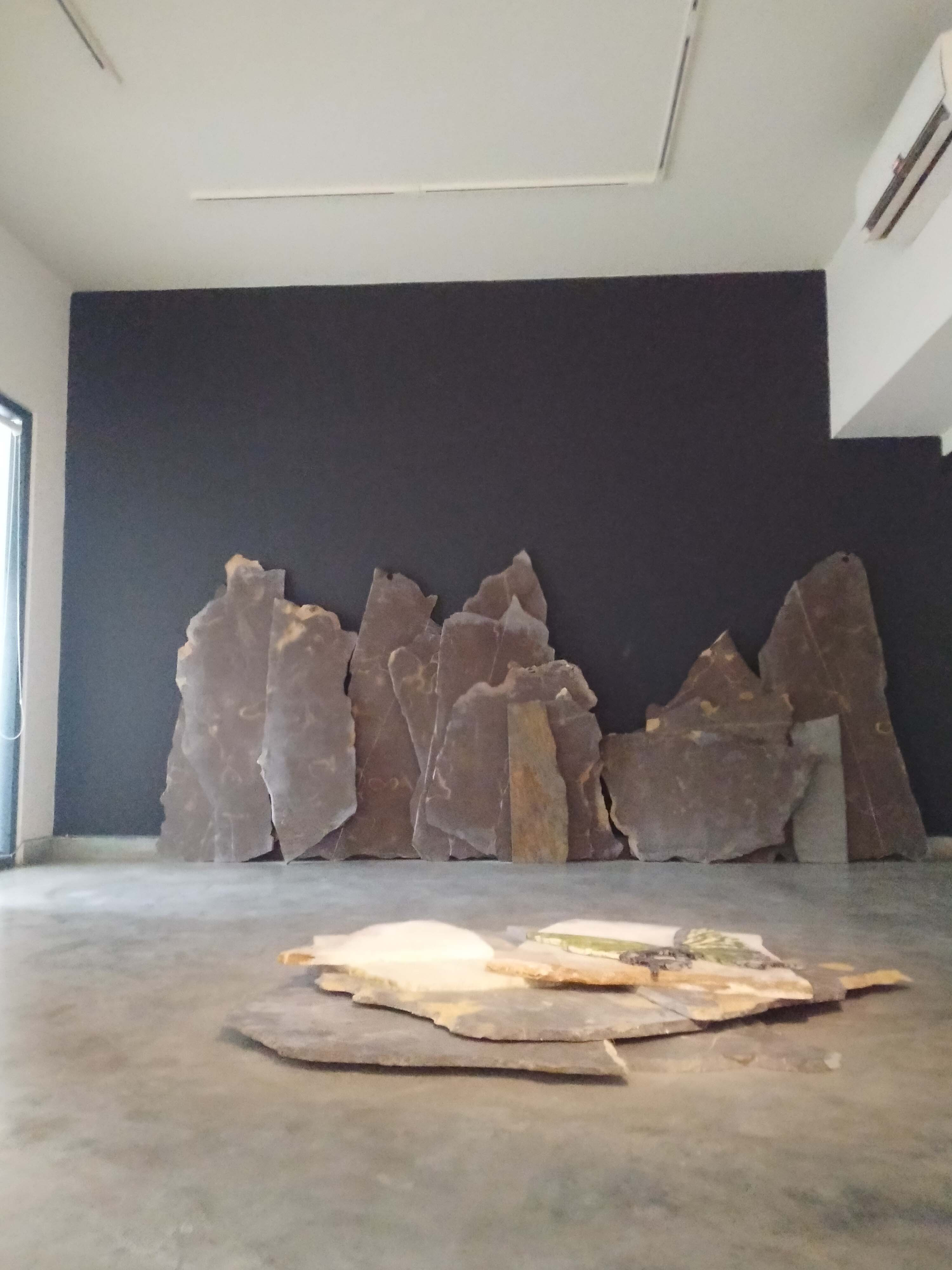
The Peshawar based Studio Lel finds its roots deep in Afghan history. It began when Farhana Asad, fascinated by captured by the hibiscus flower, wanted to recreate it in stone. She found Ustad Baryalai in the markets of Peshawar, who happened to be a master in the technique of pietra dura, a technique popularised during the Italian Renaissance.
In the heart of this Renaissance was lapis lazuli, a stone from Afghanistan that took Europe by storm. This exquisitely blue coloured stone is the crowning jewel of the Sistine Chapel.
Pietra dura is an Italian word for ‘hard stone’ and is a technique involving stone marquetry or stone inlay, that uses coloured stones to make forms and images. Lapis Lazuli from Afghanistan was widely used for its brilliant blue in this technique. But one of the best examples of pietra dura comes from the Mughals in the form of Taj Mahal.
The title of the exhibition,War Gardens, comes from a book by author Lalage Snow who travelled to war stricken areas around the world, collecting stories of the small gardens, built as monuments of resilience, but more importantly pockets of havens in times of turmoil.

War Garden is an apt title for this show as it reflects on the terrible conditions of Northern Pakistan during the NATO war. Mehrunnisa recalls the gut-wrenching sounds of the American drones and jets flying from their base in Peshawar airport, where the Studio Lel workshop is located. This work comes as a tribute to the artisan refugees of Afghanistan, and the local artisans of Khyber Pakhtoonkhuwa (KPK) who lost their life's work in displacement caused by wars of greed fought by men sitting on iron thrones, behind barbed wires, in their concrete castles, far removed from the reality of the common folk.
While the backdrop of the theme of this collection is harrowing, Mehrunnisa chooses to dispel the imagery of violence to celebrate beauty and craft of these artisans. While the exhibition brings forth the topic of political unrest in Peshawar during the NATO war period. The work put together in War Gardens focuses on resilience instead of trauma. One of the most impressive pieces of the collection ‘Zer Yak Asmaan’ features a shaheen (falcon) and a predatory panther. This piece in particular summarises the situation in Northern Pakistan. The falcon, despite its small size, appears to be fighting back. On the backdrop of these characters is a scenic view of lotuses and flowering trees. The falcon is a symbol representing the people of Pakistan, an emblem popularised by Allama Iqbal. The Panther are the enemies, particularly the Americans, who were killing millions of Pakistanis regularly in their drone attacks and the Taliban who massacred thousands in suicide bombing. The flowering backdrop seems to pay homage to the hope in beauty of the region, the innocent people and the culture of KPK and Afghanistan. ‘Zer Yak Asmaan’ combines the techniques of copperwork, pietra dura, scagliola and cloisonné. It is work that emanates mastery of craft, composition and apologue.
One of the most interesting curatorial decisions was starting the show from the display of raw stone slabs. As one moves around the exhibition, it is quite shocking to realise such immense beauty can be derived from the unassuming slabs of stone.

Alongside its theme, a very crucial reflection of Studio’s Lel’s work is on the discourse of art vs craft.
Mehrunnisa recounted that they were rejected by many galleries to showcase their work since it is not considered to be “high art”. She was grateful to Noorjehan Bilgrami for her support and enthusiasm for showcasing Studio Lel’s work with the respect and recognition it deserves. Noorjehan herself has worked extensively with crafts people in Pakistan, and her appreciation and promotion of craftsmanship as an art form is significant, especially in the context of South Asia.
South Asia has a history of breathtaking craft culture, and was patronised by kings and nobles of this region and the foreign alike. Works of South Asian craftsmen rival works of their European counterparts but get not even a fraction of that recognition in academic or art circles. This is the extremely unfortunate postcolonial condition we have found ourselves in. While in Japan, the artisans and craftsmen carrying traditional practices are revered, craftsmen and artisans in Pakistan find themselves often in poverty and neglect.

This exhibition blurs the boundaries between the definition of art and craft. Post- Impressionist schools of art, particularly Dadaism onwards, have caused a divorce between skill of craft-making and conceptualisation of art-making. Often times, contemporary art world rejects craftsmanship as part of art because it is seen as lacking in thought.
When you consider art in the Islamic context, craft and philosophy go hand in hand. Islamic arts such as illumination of manuscripts or fresco paintings in mosques are deeply spiritual in nature. Other than the fact that many patterns used in these crafts are symbols of spiritual values, there is also this idea of practising art as worship. These art forms include music, architecture, and writing too. Islamic artists are taught to do ablution before they work, because their work is an extension of their faith. This similar thought exists in other religious arts as well, such as in Buddhism the calligraphic practice is considered to be deeply spiritual and sacred.

This discourse becomes relevant here because in many ways pietra dura was considered to be one of the spiritual arts in South Asia. It was used in ornamentation of mosques and tombs. Even the everyday objects, such as jewellery boxes or trays, that use this technique must be considered to belong within the realm of Islamic art since in the past there was no distinction between different spheres of life.
This exhibition was not only a celebration but a challenge too. It celebrated masterful craftsmanship and collaboration of karkhana (workshop) structures of traditional art forms. It is also a challenge to the very bleak western contemporary definitions of what art means. Most importantly, it is a challenge to the idea of destruction and war and how on the flip side of the coin there is beauty found there, that must be cherished and preserved for the hope it provides.
Lulu Lokhandwala is a visual artist and researcher. You can follow her work on Instagram at @luluwa.lokhandwala
All facts and information are the sole responsibility of the writer




1732184775-0/BeFunky-collage-(80)1732184775-0-165x106.webp)

1732189200-0/Express-Tribune-(13)1732189200-0-270x192.webp)
1732184492-0/BeFunk_§_]__-(25)1732184492-0.jpg)

1732179298-0/BeFunk_§_]__-(23)1732179298-0.jpg)

1732181665-0/Express-Tribune-(9)1732181665-0-270x192.webp)






COMMENTS
Comments are moderated and generally will be posted if they are on-topic and not abusive.
For more information, please see our Comments FAQ